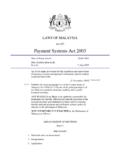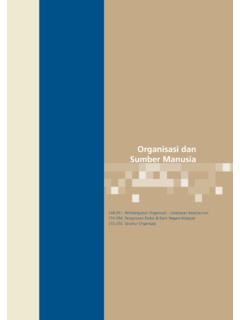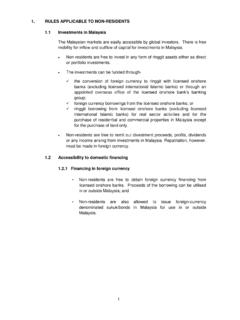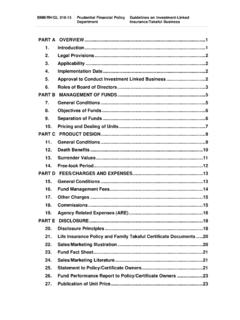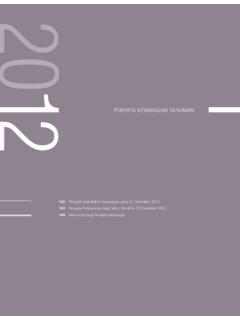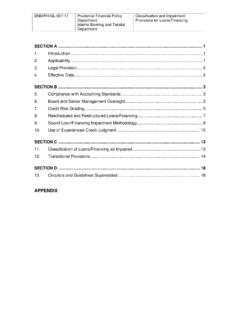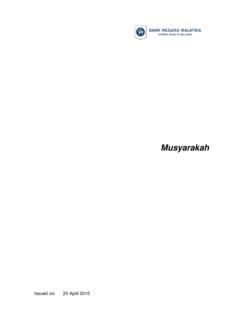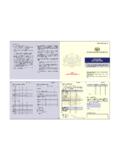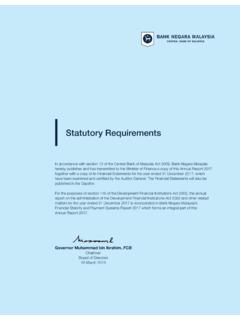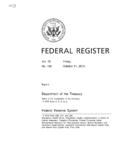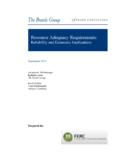Transcription of Risk-Based Capital Framework for Insurers [Version …
1 Issued on: 20 June 2013 Risk-Based Capital Framework for Insurers [ version ] PART A OVERVIEW .. 1 1. Objectives .. 1 2. Legal provisions .. 2 3. Applicability .. 2 4. Effective date .. 3 5. [Deleted].. 3 PART B Capital ADEQUACY .. 4 6. Capital Adequacy Ratio the formula .. 4 7. Total Capital available .. 5 8. Deductions from Capital .. 7 9. Total Capital required .. 7 PART C Capital REQUIRED TO MITIGATE MAJOR RISKS .. 8 10. Total Capital required .. 8 11. Capital charges for credit risk .. 8 12. Capital charges for market risk .. 9 13. Capital charges for general insurance liabilities .. 9 14. Capital charges for life insurance liabilities .. 11 15. Capital charge for operational risk .. 12 16. Surrender value Capital charges .. 13 PART D VALUATION OF ASSETS AND LIABILITIES .. 14 17. Overview .. 14 18. Valuation of assets .. 14 19. Valuation of liabilities.
2 14 20. [Deleted].. 16 21. [Deleted].. 16 PART E INVESTMENT OF INSURANCE FUNDS .. 17 22. Investment and risk management policy .. 17 PART F INDIVIDUAL AND SUPERVISORY TARGET Capital LEVELS . 20 23. Individual Target Capital Level .. 20 24. Supervisory target under the Risk-Based Supervisory Framework 21 25. Restrictions on payment of dividends .. 22 PART G RELEVANT ISSUES .. 23 26. Capital adequacy 23 27. Minimum paid-up Capital .. 23 PART H Appendices .. 24 Appendix I Credit Risk Capital Charges .. 24 Appendix II Market Risk Capital Charges .. 38 Appendix III Investment and Individual Counterparty Limits .. 57 Appendix IV Risk Charges for General Insurance Liabilities .. 61 Appendix V Stress Factors for Life Insurance Liabilities .. 62 Appendix VI Valuation Basis for General Insurance Liabilities .. 63 Appendix VI(a) The Report on Reserves for General Insurance Business for the year ended 20XX.
3 85 Appendix VI(b) Additional Guidance Notes for Inwards Reinsurance .. 93 Appendix VI(c) Guidance Notes for the Presentation of the Valuation of Claim Liabilities .. 97 Appendix VI(d) Workflow of the Computation of Table 1: Claims Liabilities. 99 Appendix VI(e) Guidance Notes for the Presentation of the Valuation of Premium Liabilities .. 100 Appendix VI(f) Workflow of the Computation of Table 2: Premium Liabilities .. 103 Appendix VI(g) Summary of Claims and Premium Liabilities .. 104 Appendix VII Valuation Basis for Life Insurance Liabilities .. 105 Appendix VII(a) Report on Actuarial Valuation of Life Insurance Liabilities for the year ended dd/mm/yyyy .. 120 Appendix VII(a)(i) Summary of Valuation Result .. 124 Appendix VII(a)(ii) Valuation Result, Composition and Distribution of Surplus .. 126 Appendix VIII [Deleted] .. 128 Appendix IX Appointed Actuary and Signing Actuary.
4 129 Appendix X Rating Categories and Risk Charges .. 132 BNM/RH/GL 003-24 Prudential Financial Policy Department Risk-Based Capital Framework for Insurers [ version ] Page 1/132 PART A OVERVIEW 1. Objectives The requirements detailed in the Risk-Based Capital (RBC) Framework (the Framework ) aim to ensure that each insurer maintains a Capital adequacy level that is commensurate with its risk profile at all times. The Framework has been developed based on the following principles: (i) Allowing greater flexibility for an insurer to operate at different risk levels in line with its business strategies, so long as it holds commensurate Capital and observes the prudential safeguards set by Bank Negara Malaysia (the Bank); (ii) Explicit quantification of the prudential buffer with the aim of improving transparency; (iii) Providing incentives for Insurers to put in place appropriate risk management infrastructure and adopt prudent practices; (iv) Promoting convergence with international practices so as to enhance comparability across jurisdictions and reduce opportunities for regulatory arbitrage within the financial sector.
5 And (v) Providing an early warning signal on the deterioration in Capital adequacy level, hence allowing prompt and pre-emptive supervisory actions to be taken. The Framework sets out: (i) Requirements applicable to each insurer to determine the adequacy of the Capital available in its insurance and shareholders funds to support the Total Capital Required (TCR). This serves as a key indicator of the insurer s financial resilience, and will be used as input to determine supervisory interventions by the Bank. BNM/RH/GL 003-24 Prudential Financial Policy Department Risk-Based Capital Framework for Insurers [ version ] Page 2/132 (ii) The statutory valuation bases for Insurers assets and liabilities and the Bank s expectations on the investment and risk management policies of Insurers . 2. Legal provisions The requirements in the Framework are issued pursuant to Section 23 of the Insurance Act 1996 (Act).
6 3. Applicability The requirements in the Framework are applicable to all Insurers , including reinsurers, licensed under the Act for businesses generated from within and outside Malaysia. Unless otherwise mentioned, the term insurer under the Framework includes a professional reinsurer, as defined in the Act. Businesses outside Malaysia generated by a branch of a foreign insurer may be exempted from the requirements of the Framework , subject to the Bank s prior approval where: (i) there is an explicit undertaking from the branch s head office to satisfy the liabilities arising from businesses outside Malaysia in the event that the branch is unable to fulfil its obligations; (ii) the financial position of the foreign branch s group is strong; (iii) the branch is subjected to consolidated supervision by a recognised and competent home supervisory authority; and (iv) the foreign insurer s home supervisory authority is willing to cooperate with the Bank in the supervision of the insurer .
7 BNM/RH/GL 003-24 Prudential Financial Policy Department Risk-Based Capital Framework for Insurers [ version ] Page 3/132 4. Effective date The Framework takes effect from 1 January 2009. 5. [Deleted] BNM/RH/GL 003-24 Prudential Financial Policy Department Risk-Based Capital Framework for Insurers [ version ] Page 4/132 PART B Capital ADEQUACY 6. Capital Adequacy Ratio the formula The Capital Adequacy Ratio (CAR) measures the adequacy of the Capital available in the insurance and shareholders funds of the insurer to support the total Capital required. The formula to compute the CAR is as follows: %100 XequiredRCapitalTotalAvailableCapitalTot alCAR= For a life insurer with participating business, the CAR shall be computed as follows: () ,_min= where, - ,_fundsallCAR is the CAR taking into account all the insurance and shareholders funds; and - is the CAR taking into account all the insurance and shareholders funds, excluding the participating life insurance fund.
8 The modified computation method reflects the ability of life Insurers , subject to meeting policyholders reasonable expectations, to adjust the level of non-guaranteed benefits to take into account the emerging experience of the participating life insurance fund. It also preserves the fundamental principle that the valuation surplus of the participating life insurance fund should not be used to support the Capital requirement of other insurance or shareholders funds. BNM/RH/GL 003-24 Prudential Financial Policy Department Risk-Based Capital Framework for Insurers [ version ] Page 5/132 7. Total Capital available The Total Capital Available (TCA) of an insurer is the aggregate of Tier 1 and Tier 2 Capital of the insurer less deductions in paragraph The main criteria used in the classification of a Capital element into Tier 1 or Tier 2 categories is the degree of its permanence and whether it is free and clear of any encumbrances.
9 The total amount of Tier 2 Capital must not exceed the amount of Tier 1 Capital . Tier 1 Capital of an insurer is the aggregate of the following: (i) issued and fully paid-up ordinary shares (or working fund, in the case of a branch of a foreign insurer ); (ii) share premiums; (iii) paid-up non-cumulative irredeemable preference shares; (iv) Capital reserves; (v) retained profits1; (vi) the valuation surplus2 maintained in the insurance funds; and (vii) 50% of future bonuses3. Capital instruments which qualify as Tier 2 Capital include: (i) cumulative irredeemable preference shares; (ii) mandatory4 Capital loan stocks and other similar Capital instruments; (iii) irredeemable subordinated debts; 1 In the event that an insurer has accumulated losses, the losses should be deducted from the Capital .
10 2 Gross of deferred tax, if any. 3 Future bonuses defined as max [zero; the difference between the Par reserves on total benefits and Par reserves on guaranteed benefits only, calculated on the bases described in Paragraph of Appendix VII]. For the purpose of determining future bonuses, the value of 'Par reserves on guaranteed benefits only' should be zerorised if it is negative. 4 Refers to irredeemable loans stocks or Capital instruments which are mandatorily convertible to equity. BNM/RH/GL 003-24 Prudential Financial Policy Department Risk-Based Capital Framework for Insurers [ version ] Page 6/132 (iv) available-for-sale reserves5; (v) revaluation reserves for self-occupied properties and other assets; (vi) general reserves; and (vii) subordinated term debts. Subordinated term debts would, subject to the prior approval of the Bank on a case-to-case basis, include term debt and limited life redeemable preference shares which satisfy the following conditions: (i) unsecured, subordinated and fully paid-up; (ii) a minimum original fixed term to maturity of five years; (iii) early repayment or redemption shall not be made without prior consent of the Bank; (iv) the instruments should be subjected to straight line amortisation over the last five years of their life6; (v) there should be no restrictive covenants; and (vi) the amount eligible for inclusion shall not exceed 50% of Tier 1 Capital .
